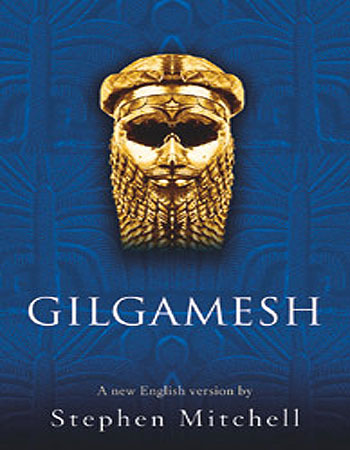
Gilgamesh
A few years ago when I was asked on a radio talk show which single work of literature I would take to a desert island, I had no hesitation. My choice was Gilgamesh, the ancient Mesopotamian myth-poem which, composed more than 4000 years ago, is acknowledged as the world’s oldest literary creation.
I used the term “myth-poem” to describe Gilgamesh. But it is much more. It is also a novel, a thriller, a play, the libretto for an opera, a scenario for a film, a philosophical treatise, and even a sparkling text for a fast-paced comic strip. Inscribed on stone tablets, by an Akkadian monk named Sîn-lëqi-unninni’s, the epic was buried during the fall of Nineveh , its language forgotten, not to be recovered and deciphered until the 19th century.
Since I first discovered Gilgamesh in 1964 I have returned to read and re-read it at least once every other year. I have also read it in the few languages I know, that, sadly, do not include Akkadian, in which the original text was composed. And, yet, each time there is a new edition I am excited all over again. This text has the unique quality of making you fall in love with it again and again and again.
So you can imagine how excited I am to run into a new English version of Gilgamesh. This is produced by the American poet Stephen Mitchell who is already known for his re-renditions of several Chinese and Indian classical texts.
Written in free verse this version succeeds in maintaining the balance between the solemnity that so ancient a text demands and the lightness that lies at its heart. Mitchell has struck the right pitch, offering a narrative in which tension is built up or down as each dramatic scene requires.
A “designer baby’ willed into being by the goddess Aruru, Gilgamesh is “huge, handsome, radiant, perfect.” Propelled into the position of the King of Uruk, however, he fails to distinguish strength from arrogance and ends up losing popular support.
Instead of revolting against him, as men would subsequently learn to do against tyrannical rulers, the people of Uruk take their complain to the gods. And those gods of ancient Uruk, unlike future gods, have what looks like a postmodernist approach to the problem. Rather than wiping the ruler off the face of the earth or burning his kingdom with a lightning strike, they diagnose his misbehavior as a result of solitude. So they create Enkidu as the plebeian who can complement Gilgamesh by becoming his friend-cum-rival in strength. In other words, friendship is a divine cure for evil in man.
Enkidu and Gilgamesh become inseparable friends after a bout of wrestling which ends in a draw, indicating that an ordinary subject could be equal to the king . Enkidu’s eventual death hits Gilgamesh hard. Wishing to avoid his own death, he goes in search of the secret of immortality but returns empty handed. Realising that his efforts have been in vain, he resigns himself to the inevitability of death and comes to see that man can achieve immortality only through enduring work.
Gilgamesh could be read as the world’s first novel and , despite its slimness, contains virtually all the big themes and plots of narrative fiction.
It is a Bildungsroman in the sense that it narrates the growing-up experience of its hero. But it also a story of friendship- of the kind Homer wove around Achilles and Patraculus. Gilgamesh could also be read as a boys’ adventure story full of dangerous encounters and monsters to kill. It has environmental themes in the sense that the killing of Humbaba, the monster of the forest, may well be a symbol of the coming of the clearing of woodlands and the advent of agriculture. I must admit that I have always had a soft spot for Humbaba who was only doing his job, protecting the forest against those who wished to cut it down- a figure that Green Peace could adopt as its mascot.
Gilgamesh contains oldest version of the story of the flood which is subsequently featured in all Semitic belief systems. It is also about building the first walled cities and thus the emergence of urban consciousness, and the shaping of a government administration complete with a bureaucracy.
On a lighter note, the epic is full of erotic charge not least in Gilgamesh’s skirt-chasing shenanigans which eventually undermine his popularity ratings at home. The erotic charge achieves a Hiroshima-size explosion when Enkidu, who had no need of the blue pill, makes love to the sexy priestess Shamhat for “seven days and seven nights, non-stop.”
As far as special effects are concerned, Walt Disney or George Lucas could not have done better. Here we have flood and fire at the same time with the rumblings of an earth on the verge of explosion hissing under the surface.
Shiduri, the tavern keeper, and Ereshkigal, the Queen of the Underworld, and a sister of the goddess Ishtar, inject philosophical themes into the story. Ishtar herself appears as the quintessential femme-fatale , a postmodern tigress. One could imagine her wearing tight leather trousers and matching jacket, with a generous aperture in front, and cracking a whip while driving a Maserati, oops, I mean a chariot driven by seven white steeds.
But it is
Ereshkigal that takes the seven veils off
existence to show the truth of our human condition:
“Humans are born, they live, then they die,
this is the order that the gods have decreed.
But until the end comes, enjoy your life,
spend it in happiness, not despair.
Savor your food, make each of your days a delight,
bathe and anoint yourself, wear bright clothes that
are sparkling clean, let music and dancing fill your
house, love the child who holds you by the hand,
and give your wife pleasure in your embrace.
That is the best way for a man to live.”
It is indeed!
